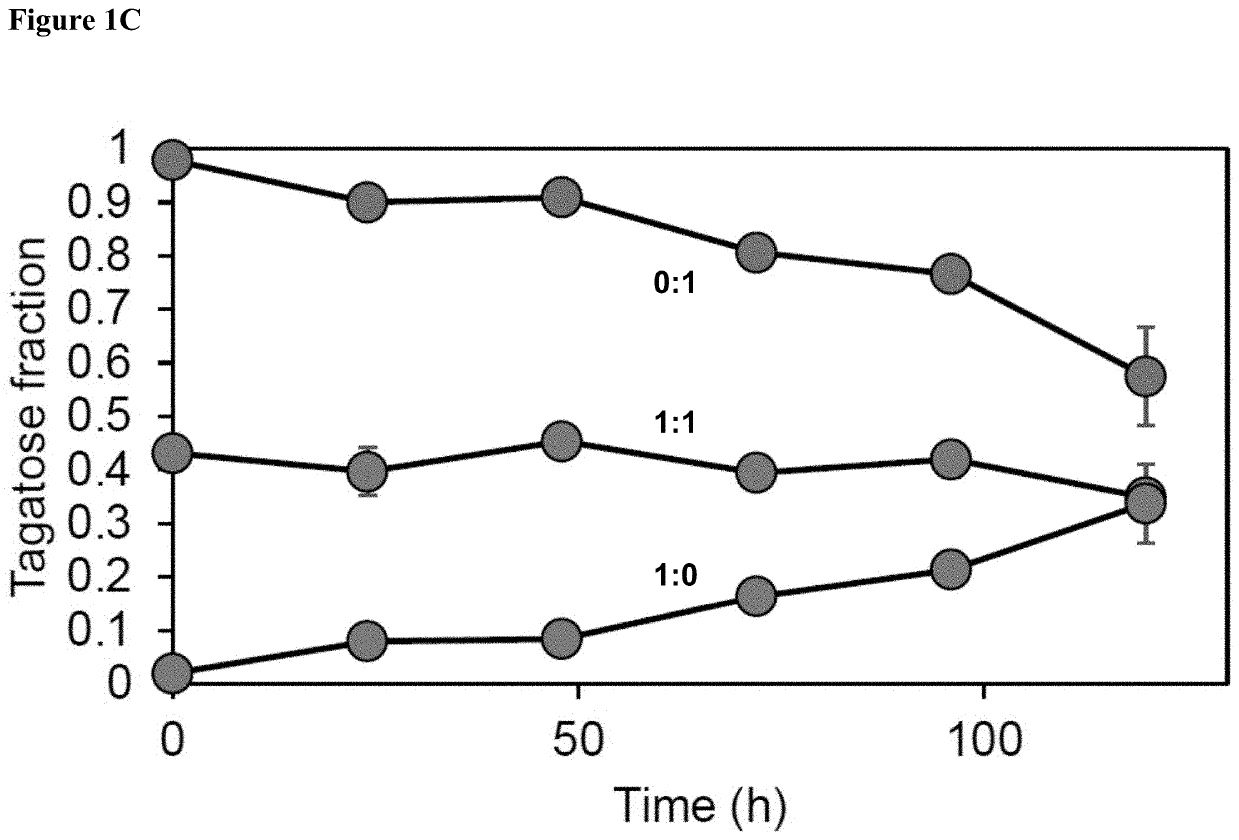Galactose to tagatose isomerization at moderate temperatures with high conversion and productivity
a technology of tagatose and isomerization, which is applied in the field of components and methods for preparing saccharides, can solve the problems of low glycemic index and caloric value, affecting commercial viability of tagatose biosynthesis using lai, and low enzyme stability
- Summary
- Abstract
- Description
- Claims
- Application Information
AI Technical Summary
Benefits of technology
Problems solved by technology
Method used
Image
Examples
example 1
to Tagatose Isomerization at Moderate Temperatures with High Conversion and Productivity
[0154]Reference is made to Bober & Nair, “Galactose to tagatose isomerization at moderate temperatures with high conversion and productivity,” bioRxiv, first posted online Feb. 12, 2019, now published in Nat. Comm. (2019)10:4548, Oct. 7, 2019, the content of which is incorporated herein by reference in its entirety.
[0155]Abstract
[0156]There are many industrially-relevant enzymes that while active, are severely limited by thermodynamic, kinetic, or stability issues (isomerases, lyases, transglycosidases). In this work, we study Lactobacillus sakei L-arabinose isomerase (LsLAI) for D-galactose to D-tagatose isomerization—that is limited by all three reaction parameters. The enzyme demonstrates low catalytic efficiency, low thermostability at temperatures >40° C., and equilibrium conversion Lactobacillus plantarum that is chemically permeabilized enables reactions at high rates, conversion, and temp...
example 2
nversions of Galactose to Tagatose at Elevated Reaction Temperature and Adaptation of Lp Cells to Grow at Elevated Temperatures
[0269]We sought to increase the productivity and yield of the rate sugar tagatose via galactose isomerization by building on the technology we developed in Example 1, we illustrates a high level of tagatose production using whole cell Lactobacillus plantarum (Lp) expressing L-arabinose isomerase (LAI) from L. sakei (LsH). To achieve higher productivity, we tested another LAI from L. plantarum, (LpH), which is more thermostable than LsH (60° C., Chouayekh et al., 2007 vs. 40° C., Rhimi et al., 2010). At 50° C., LpH showed higher conversion (50%) to tagatose than LsH (40%) (FIG. 16A). However, at 60° C. LpH gave lower yield (45%) compared to LsH (52%), suggesting LsH may be a better candidate for tagatose production even at elevated temperatures. We also evaluated Saccharomyces cerevisiae (Sc) as biocatalyst for tagatose production using LpH (FIG. 16B). We tes...
PUM
| Property | Measurement | Unit |
|---|---|---|
| Temperature | aaaaa | aaaaa |
| Fraction | aaaaa | aaaaa |
| Time | aaaaa | aaaaa |
Abstract
Description
Claims
Application Information
 Login to View More
Login to View More - R&D
- Intellectual Property
- Life Sciences
- Materials
- Tech Scout
- Unparalleled Data Quality
- Higher Quality Content
- 60% Fewer Hallucinations
Browse by: Latest US Patents, China's latest patents, Technical Efficacy Thesaurus, Application Domain, Technology Topic, Popular Technical Reports.
© 2025 PatSnap. All rights reserved.Legal|Privacy policy|Modern Slavery Act Transparency Statement|Sitemap|About US| Contact US: help@patsnap.com



